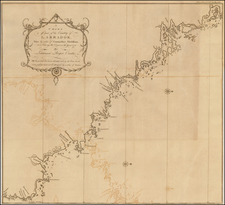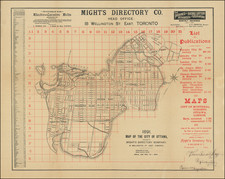A Klondike / Yukon Rarity -- Emphasizing the "Stickeen Route" to the Gold Fields
Finely executed map of the Klondike gold mining regions and the various routes to the mining regions, published in Edinburgh by leading mapmaker W. & A.K. Johnston in Edinburgh, one of the only maps of the region to emphasize the Stickeen Route and then planned railroad to the Gold Regions via Telegraph Creek and Glenora.
The map provides a remarkably clear and detailed treatment of the various routes to the gold regions in the Klondike and Yukon regions. Also, unlike most other gold rush era maps of the region, the focal point is shifted eastward, such that map is centered on the overland routes originating from the Juneau area and Fort Rangel, allowing for considerably more detail than other maps of the region, most of which tend to be more centered on either the Yukon River or the whole of Alaska.
This is one of the earliest separately pubilshed maps of the Klondike Gold Rush published outside of America, reflecting the spreading interest in this gold rush, which would change the landscape of the Yukon and environs. While a number of maps would be published in the United States, this is one of the few maps promoting the Klondike outside North America and may also relate to efforts to raise money for the construction of the railroad in England.
On the verso, the text provides an excellent historical overview of the discovery of gold in Alaska, earlier strikes and the beginning of the current boom in 1896, with a rich narrative of the mining successes enjoyed by miners working in the 1897 mining season.
Of note is the lengthy explanation of the Canadian Government's having "concluded acontract for building a railway to the Ukon [via the Stickeen Rirver]," with a detailed description of the route and the means for recovering its construction and costs through the fares charged on the route for the first decade of operation. An explation of the Klondike and the land and water routes thereto is given, including:
- Water Routes via the Yukon River (30 days)
- The White Pass Route (21 days)
- The Stickeen Route (10 days when railway finished)
- The Chilkoot Pass Route (27 days)
The "Regulations Governing the issue of leases to dredge for minerals in the bes of Rivers in the Provisional District of the Ukon, North-West Territories" are also given.
Klondike Gold Rush
The Klondike Gold Rush (1896-99) was one of the most sensational events of the fin de siècle ("end of century") period. Gold was first discovered in the Klondike in what was then Canada's Northwest Territory on August 16, 1896. News quickly spread across North America from what was about the most remote corner of the continent. Newspapers exaggerated the potential of the bonanza in an effort to sell copies, and a mass sensation was born.
Over 100,000 people headed towards the Yukon. However, the region proved so inaccessible only 30,000 prospectors and "entrepreneurs" actually arrived in the area near Dawson City. Nevertheless, as shown on the map, for three years this migration utterly transformed the area that was caught up in an atmosphere of frenetic ambition and frontier lawlessness. While the Yukon proved be nothing like the El Dorado promised by the newspapers, the "Klondike" has since occupied a cherished place in North American lore.
Stickine or Stickeen Route
From 1897 to 1898, the Stickine or Stickeen Route was one of the laborious routes to the Klondike Gold Rush in the Yukon Territory. Several railway schemes were floated to provide an "All Canadian" route to the Dawson goldfields—A Teslin Railway, Omineca Railway, and the Canadian Yukon Railway promoted by the CPR. Railway contractors were hired and ready to build the route, though the Federal Senate and American government prevented the 500-mile project from proceeding. Several river steamers were built to haul materials to Glenora to aid the project. The April 1, 1898 issue of The Klondike News (Vol. 1, No. 1), published in Dawson City, gave the following account of the route
The Stickine Route
One of the advantages this route is supposed to enjoy is its freedom from rough and dangerous water, such as the White Horse Rapids. While it is true that by going this way one would escape the danger of walking around the White Horse Rapids and the expense of sending the boat through by tramway, we would suggest that there are only a few hundred yards of rough water in the White Horse Rapids, and there are 150 miles of Stickine River, and a more swift, crooked and dangerous river does not flow.
The portage of 150 miles from Telegraph Creek to Teslin Lake is one that the traveler will never forget, even though made over a wagon road, and we would advise our friends to wait until the long-talked-of railroad is completed and go over this route by Pullman car.
Rarity
The map is extrmely rare, with copies in American Libraries and no record of any examples being offered for sale at auction or in dealer catalogues.
OCLC locates 4 examples (British Library, Bibliotheque National de France, National Library of Scotland, Manchester University (UK) . We also note a copy in the Warren Heckrotte illustrated collection at Stanford University (the same example we are offering for sale)












![[ Highlighting Routes To The Gold Regions ] Map of Alaska Compiled from the official Records of the General Land Office, U.S. Coast and Geodetic Survey and other sources . . . 1898](https://storage.googleapis.com/raremaps/img/small/98404.jpg)
![Carte Qui Contient La Maniere Dont Se Fait La Chasse Des Bouefs Sauvages . . . [Buffalo, Niagara Falls, Calumet Village, Huron & Illinois Indians]](https://storage.googleapis.com/raremaps/img/small/93146.jpg)
![[ Queen Anne's War - Failed Attack on French Canada -- Petition to Queen Anne from the Colony of New York seeking reimbursement for a failed conquest of New France during Queen Anne's War ] To the Queens most Excellent Majesty . . . 1709](https://storage.googleapis.com/raremaps/img/small/85409.jpg)
![[ Karte des Nordens von America, Zur Beurtheilung der Wahrscheinlichkeit einer nord=westlichen Durchfhart, gezeichnet von G. Forster, 1791.]](https://storage.googleapis.com/raremaps/img/small/41816dm.jpg)
